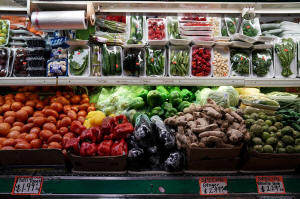US consumer sentiment slips; inflation expectations increase
 Send a link to a friend
Send a link to a friend
 [April 13, 2024] By
Lucia Mutikani [April 13, 2024] By
Lucia Mutikani
WASHINGTON (Reuters) - U.S. consumer sentiment receded in April and
households expected inflation to increase over the next 12 months and
beyond, likely providing more ammunition for the Federal Reserve to
delay cutting interest rates until September.
The survey from the University of Michigan on Friday followed data this
week that showed consumer prices increased more than expected for a
third straight month in March.
Stubbornly high inflation and a strong labor market prompted financial
markets and most economists to sharply dial back their expectations for
the first rate cut from the U.S. central bank to September from June.
They also have lowered the number of anticipated rate cuts to two from
three.
But inflation is not spiraling out of control, with producer prices
increasing moderately last month. That was reinforced by other data on
Friday showing import prices excluding fuels barely rose in March after
surging at the start of the year.
"This increase in inflation expectations is not what the Fed wants to
see, but despite the increase, they remain in line with the recent trend
and are well-anchored," said Eugenio Aleman, chief economist at Raymond
James.
The University of Michigan's preliminary reading on the overall index of
consumer sentiment came in at 77.9 this month, compared to a final
reading of 79.4 in March.

Since January, the sentiment index has remained within a narrow range
2.5 points, well under the 5 points which the University of Michigan
said was necessary for a statistically significant difference.
Economists polled by Reuters had forecast a preliminary reading of 79.0.
The dip in sentiment likely reflected higher gasoline prices and
occurred despite a rally on the stock market. Democrats were more upbeat
this month than Republicans and independents.
"Overall, consumers are reserving judgment about the economy in light of
the upcoming election, which, in the view of many consumers, could have
a substantial impact on the trajectory of the economy," said Joanne Hsu,
the director of the University of Michigan's Surveys of Consumers.
The survey's reading of one-year inflation expectations increased to
3.1% in April from 2.9% in March, rising just above the 2.3%-3.0% range
seen in the two years before the COVID-19 pandemic. The survey's
five-year inflation outlook rose to a five-month high of 3.0% from 2.8%
in the prior month.
Stocks on Wall Street were trading lower. The dollar rose against a
basket of currencies. U.S. Treasury yields fell.
IMPORT PRICES INCREASE
A report from the Labor Department's Bureau of Labor Statistics showed
import prices rose 0.4% in March after an unrevised 0.3% gain in
February. Economists had expected import prices, which exclude tariffs,
to rise 0.3%.
[to top of second column] |

Produce is seen at El Progreso Market in the Mount Pleasant
neighborhood of Washington, D.C., U.S., August 19, 2022.
REUTERS/Sarah Silbiger/File Photo

In the 12 months through March, import prices rebounded 0.4%. That
was the first year-on-year increase since January 2023, and followed
a 0.9% decline in February.
Imported fuel prices increased 4.7% in March after rising 1.3% in
February. Petroleum prices surged 6.0%, but natural gas prices
tumbled 31.9%. The cost of imported food shot up 1.6% after climbing
0.3% in the prior month.
Excluding fuels and food, import prices were unchanged. These
so-called core import prices edged up 0.1% in February. Core import
prices fell 0.4% on a year-on-year basis in March.
Import prices excluding fuels edged up 0.1% after rising 0.2% in the
prior month. They were unchanged on a year-on-year basis.
"Fed officials cannot lower their guard and rate cuts this year may
not be as numerous as earlier forecasts had projected," said
Christopher Rupkey, chief economist at FWDBONDS. "But at least the
slower increase in import prices is good news, adding to the
producer prices report yesterday, that inflation pressures may not
be raging completely out of control."
Boston Fed President Susan Collins told Reuters on Friday that she
is eyeing a couple of rate cuts this year. The U.S. central bank has
raised its benchmark overnight interest rate by 525 basis points
since March of 2022 to the current 5.25%-5.50% range, where it has
been since July.
Prices for imported capital goods dropped 0.3% last month,
potentially pointing to a moderation in business investment. The
cost of motor vehicles, parts and engines rose 0.2%. Imported
consumer goods prices excluding automotives fell 0.3%.
The cost of imported goods from China slipped 0.1% for the second
consecutive month. They dropped 2.6% on a year-on-year basis in
March. But prices of goods imported from Canada and Mexico increased
solidly.
"With market rate-cut expectations declining in recent weeks, the
dollar has rallied and bucked previous expectations for a gradual
weakening," said Matthew Martin, a U.S. economist at Oxford
Economics.
"The benefit, from an importer's perspective, is that a stronger
dollar makes imports relatively cheaper and would support lower
import price inflation in the months ahead."
(Reporting by Lucia Mutikani; Editing by Chizu Nomiyama, Andrea
Ricci and Paul Simao)
[© 2024 Thomson Reuters. All rights
reserved.]
This material may not be published,
broadcast, rewritten or redistributed.
Thompson Reuters is solely responsible for this content.
 |